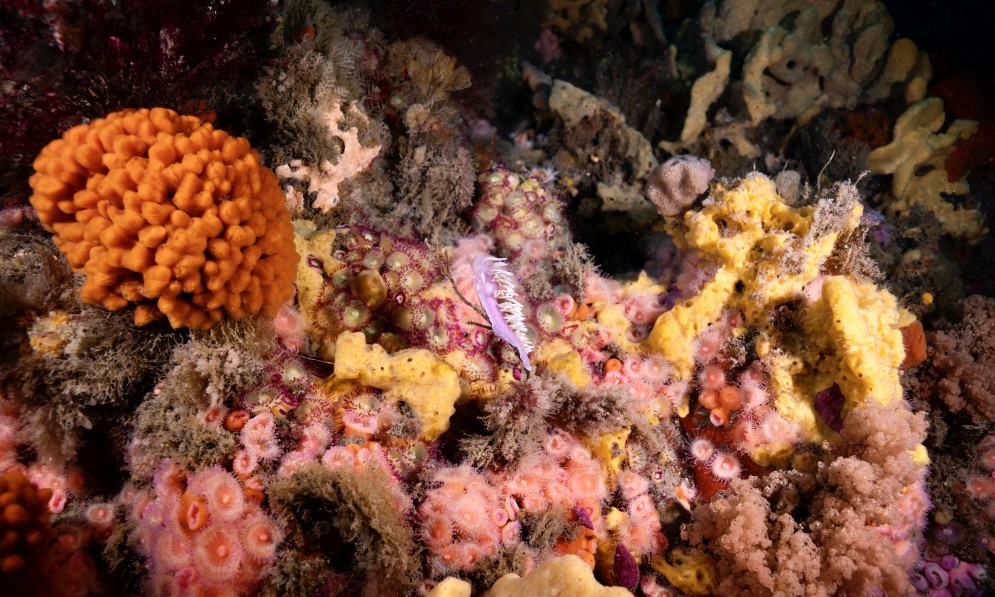A last-minute change of plans led to the exciting discovery of a previously unknown “marine animal forest” off Wellington’s west coast. We need to better protect these underappreciated and vulnerable ecosystems. By Valerio Micaroni, Francesca Strano, and Nicole Miller
That morning, we were scheduled to do an exploratory dive at one of the most inaccessible sites on the Cook Strait – a reef that lies between the North Island and the South Island and extends from 15m to more than 100m deep, beaten almost constantly by the currents of the strait, the legendary Fisherman’s Rock.
Forest & Bird magazine
A version of this story was first published in the Spring 2022 issue of Forest & Bird magazine.
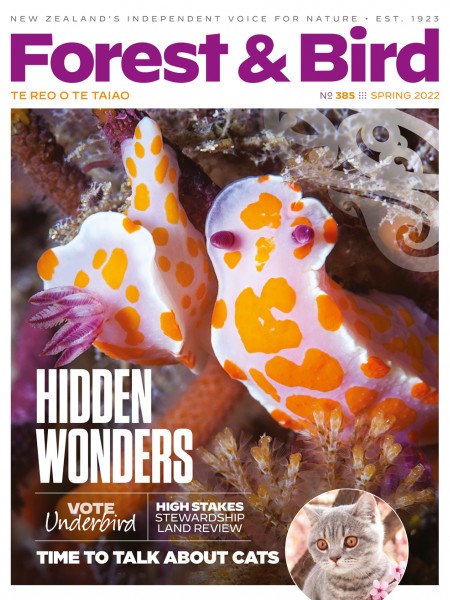
Our team consisted of some experienced divers from the Wellington Underwater Club, including us three and Rob Edwards. We were well equipped for a drift dive with underwater scooters, PLBs, and cameras, and eager to find out what organisms lived on a reef so exposed to the current and difficult to reach.
We set out from Mana Marina at first light to arrive at slack tide. But the sea conditions were different from the forecast, and soon we realised that we would have to change our plans. Disappointed, we returned closer to shore in search of a calm and sheltered area and found ideal conditions for a dive at Ohau Point, off Wellington’s west coast, south of Makara Beach. The seabed on the depth sounder looked perfect for an exploratory dive. We didn’t think twice, and after a safety briefing we jumped in the water. Going down, the visibility was poor. We still had Fisherman’s Rock in mind and were upset not to have been able to go.
"We could not believe our eyes when we found ourselves immersed in lush and vibrant sponge gardens surrounded by a thick carpet of anemones hosting a rich and diverse fish life."
Suddenly, below 15m, the water became crystal clear, and we arrived at the bottom at 25m of depth. Initially, we were surprised by the complexity of the seabed: steep pinnacles and rocky outcrops were scattered on a coarse sandy bottom, creating a dramatic seascape. But as soon as we turned on the torches we were blown away by the beauty that surrounded us. Every inch of rock was soaked with life, and the sand was covered by a carpet of white-striped anemones (Anthothoe albocincta) that seemed like a meadow of daisies.
We found ourselves surrounded by a myriad of sponges, anemones, sea squirts, hydroids, and bryozoans (moss animals) of the most varied colours and shapes. Some of the sponges were huge and had probably been living there undisturbed for hundreds of years, such as the massive grey sponge, Ecionemia alata. In this wonderful habitat, an extraordinary diversity of other organisms found shelter. Extravagant nudibranchs, snails, sea stars, and crabs crowded the seafloor. Clouds of butterfly perches surrounded us and accompanied us throughout the dive. Blue moki, terakihi, and porae were coming out shyly from gullies and swim-throughs to check who the strange visitors were. We had the great fortune to land in a wonderful and relatively unknown ecosystem – like an underwater forest inhabited by marine animals rather than birds, insects, and bats!
At this depth, the dominant organisms providing structural habitat are sponges, corals, sea squirts, and bryozoans. These creatures create stunning colourful reefs, also known as “marine animal forests”. Mesophotic sponges, corals, and bryozoans can reach considerable sizes, creating complex three-dimensional structures that increase biodiversity and support marine productivity. Like terrestrial forests, these ecosystems offer habitat for a wide range of other organisms, serving as safe shelters, nurseries, breeding grounds, and feeding grounds for a multitude of animals, including commercially valuable species.
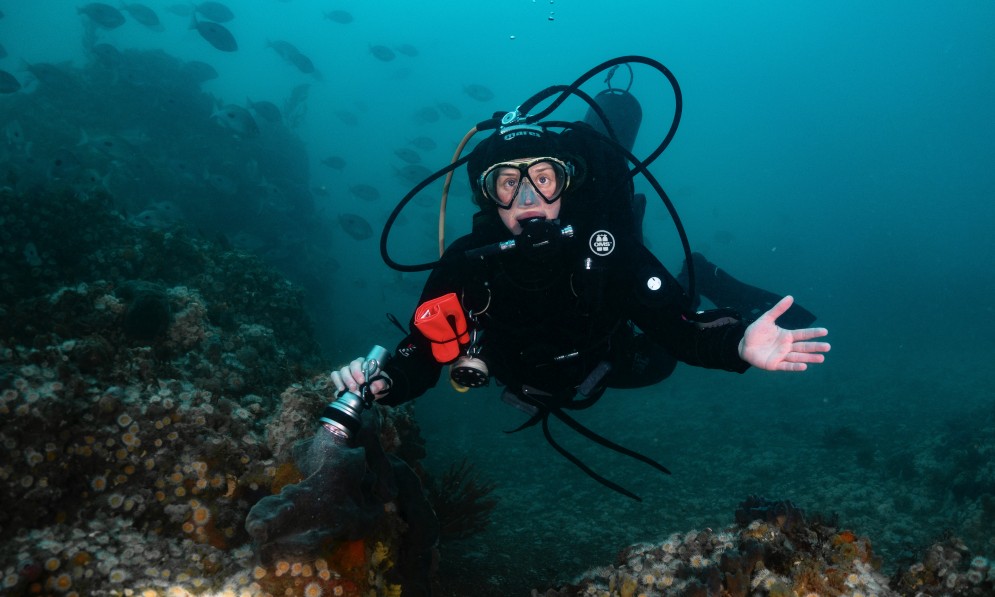
Francesca Strano floats above the mesophotic reef and sponge gardens at Ohau Point, which were discovered by chance in August 2021. Credit Valerio Micaroni
In New Zealand, famous examples of mesophotic ecosystems are found in Fiordland, where deep-sea animals such as black corals and glass sponges can be admired at snorkelling depths, and at the Poor Knights Islands, where sheer walls, shaded archways, and deep reefs are covered in non-moving invertebrates. These habitats are probably found everywhere around New Zealand, but they are not well documented because they are difficult to access.
Mesophotic organisms play key functional roles in recycling nutrients, linking the water column and the seafloor. Indeed, sponges, corals, and other mesophotic habitat-forming species are filter and suspension feeders, meaning that they feed on plankton and other small particles present in the water column. In fact, the distribution of mesophotic communities not only depends on light conditions but also on marine currents, which transport food to them.
Filter-feeders such as sponges have the very important role of capturing organic matter present in the water column and making it available as a food source for small animals living on the seafloor, such as worms, snails, shrimps, and crabs. These become food for bigger animals such as fish, making an important contribution to the marine food chain.
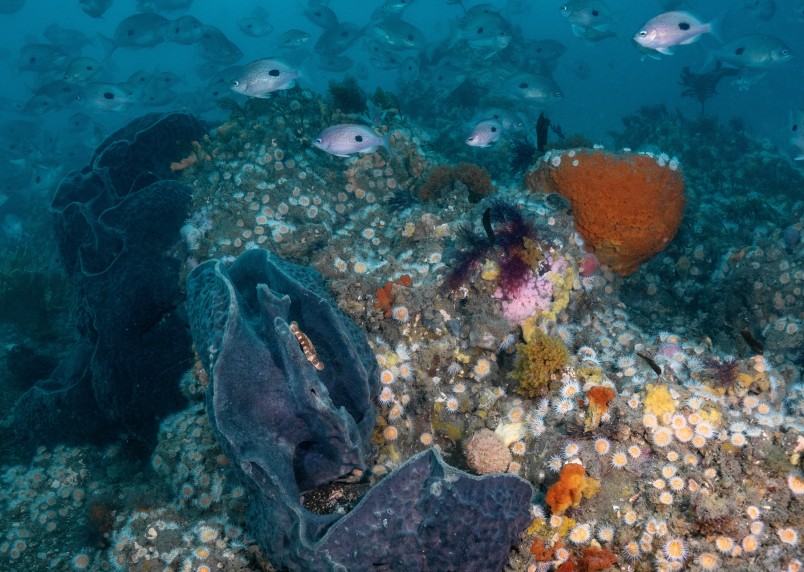
Large grey sponges, Ecionemia alata, surrounded by hundreds of butterfly perches. Credit Valerio Micaroni
Mesophotic ecosystems might also act as potential refugia from human impacts. Many mesophotic reefs occur far from the coast and are difficult to reach in areas where they are less affected by land pollution and fishing. Being less impacted, mesophotic communities could play an important role in re-seeding impacted shallow-water communities.
But temperate mesophotic ecosystems are vulnerable because of the characteristics that make them special. Many of the marine organisms that create these mesophotic forests are long lived and slow growing, taking tens to thousands of years to reach a substantial size. Because of this, mesophotic ecosystems have a limited ability to respond to human impacts, and recovery rates are often in the order of decades or centuries. As a result, the scientific community recognises mesophotic animal forests as vulnerable habitats that deserve special research attention and legal protection.
Many human activities pose a threat to mesophotic communities, including all activities that involve contact with the seabed. Many of these animals are easily damaged by any type of bottom fishing – lines and nets easily become entangled in erect organisms, creating damage and often ripping them from the bottom, while pots and anchors crush their delicate bodies. Sediment plumes raised by trawling and seabed mining can cover and smother mesophotic communities, which are composed primarily of filter-feeding animals.
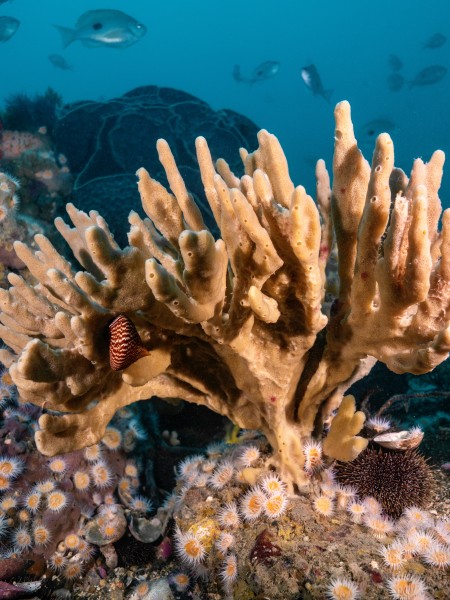
Arborescent sponge Callyspongia ramose. Credit Valerio Micaroni
Organisms living at these depths are adapted to constant low temperature conditions. As a result, these communities are particularly vulnerable to ocean warming and marine heat waves, which have already caused many die-offs in other temperate seas, such as the Mediterranean.
The discovery of mesophotic animal forests so close to the capital has sparked renewed interest in these vulnerable and largely unknown ecosystems. The road to a complete understanding of these unique marine habitats is still long and time is short. We must therefore roll up our sleeves to ensure the conservation of mesophotic ecosystems in New Zealand as in the rest of the world.
At home and overseas, mesophotic ecosystems are largely unexplored, and most still lack scientific documentation. Their exploration has been limited by the complicated logistics and technological requirements compared to shallower habitats. Indeed, mesophotic ecosystems lie beyond the limits of conventional scientific diving and require expensive specialised equipment. But, thanks to the recent technological development of underwater drones (ROVs) and technical diving, we are slowly learning more about these ecosystems and the important role they play in the oceans.
Being poorly known, mesophotic ecosystems and animal forests rarely fall under the protection of environmental legislation. Most marine reserves don’t include mesophotic reefs in their boundaries or only cover their shallower part. One of the few exceptions is Parininihi Marine Reserve in North Taranaki, which was specifically designed to protect mesophotic sponge gardens.
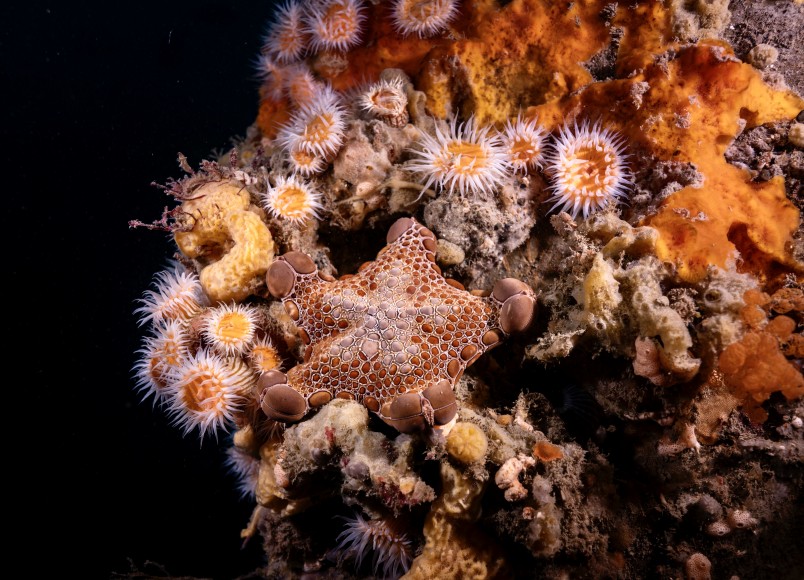
The biscuit star Pentagonaster pulchellus. Credit Valerio Micaroni
We cannot protect what we do not know. Therefore, the first step is to explore, map, and characterise the mesophotic habitats and their impacts in New Zealand. At the national level, the Department of Conservation started a project in 2020 investigating deeper reefs of Aotearoa (30–300m), aimed at drawing a more accurate picture of these ecosystems, their associated biodiversity, and the threats they are facing.
Regional councils are starting to investigate mesophotic reefs as sites of biodiversity importance. In particular, the Great Wellington Regional Council, DOC, and the Victoria University of Wellington are collaborating for the characterisation of shallow and mesophotic animal forests in the Wellington region, including the sponge garden of Ohau Point.
For more photos and videos of Ohau Point go to www.underwaterbiodiversity.com/ohau
Save our seas
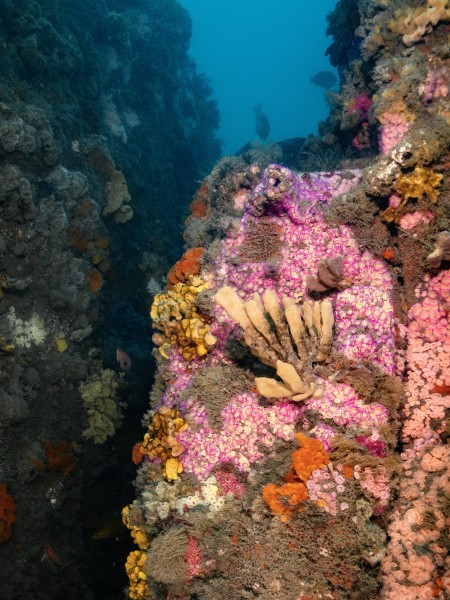
Gully covered by sponges and jewel anemones. Credit Valerio Micaroni
This exciting marine find, just a few kilometres from the capital, shows how little we know about our oceans, says Geoff Keey, Forest & Bird’s marine spokesperson.
“Thanks to the work of dedicated marine scientists like Valerio, Francesca, and Nicole, we are slowly learning more about the important functions these mesophotic animal forests provide,” he said.
“These ecosystems play an important role in mitigating marine biodiversity loss and acting as an important refugia from human impacts on our oceans, including climate change and over-fishing.
”Mesophotic means “middle-light” and marine animal forests are found between 20m and 150m, which is deeper than most scuba divers can safely work.
“It’s why they remain undescribed, unmapped, and unprotected in many countries, including New Zealand, adds Geoff.
“More research and conservation are needed to conserve these vulnerable habitats.
”Te Mana o te Taiao, the government’s Biodiversity Strategy, has a goal that significant progress will have been made in identifying and mapping marine ecosystems of high biodiversity value by 2025."
Find out more about Forest & Bird’s marine protection work
Valerio Micaroni and Francesca Strano are marine ecologists from Te Herenga Waka – Victoria University of Wellington and authors of several scientific articles in international journals on mesophotic ecosystems and other topics. Valerio has just completed his doctoral studies with a thesis on human impacts on mesophotic ecosystems. Francesca is at the end of her PhD, studying the effects of climate change on marine sponge reproduction. Their website is www.underwaterbiodiversity.com
Nicole Miller is the Chair of the Friends of Taputeranga Marine Reserve Trust, is President of the Wellington Underwater Club, and runs various marine citizen science projects – see https://adventure360.co.nz/

